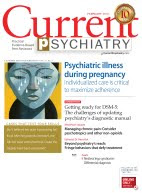Ms. B, age 48, is admitted to our hospital after overdosing on unknown amounts of amitriptyline, diphenhydramine, and laxatives. Three days after admission, the psychiatry service is consulted to assess her for “bipolar disorder.” Although Ms. B does not have a psychiatric history, her internist believes her pressured speech and psychomotor agitation warrant investigation.
During the initial psychiatric interview, Ms. B is disoriented, with fluctuating alertness and cognition. The Confusion Assessment Method for the Intensive Care Unit (CAM-ICU) is positive for delirium. We perform a delirium workup while we start Ms. B on olanzapine, 5 mg/d orally and 5 mg intramuscular (IM) every 8 hours as needed.
Ms. B’s laboratory results (complete blood count, complete metabolic profile, urinalysis, chest roentgenogram, vitamin B12 level, blood alcohol level, urine drug screen, arterial blood gas, and head CT) are unremarkable except for her amitriptyline/nortriptyline level, which is in the toxic range. On physical examination, Ms. B’s heart rate and temperature are elevated, her pupils are dilated and sluggish, and her skin is hot and dry. Based on these findings, we determine that Ms. B’s delirium most likely is an anticholinergic syndrome from amitriptyline/diphenhydramine toxicity. We discontinue olanzapine after only 2 doses because of its potential anticholinergic effects.


No comments:
Post a Comment